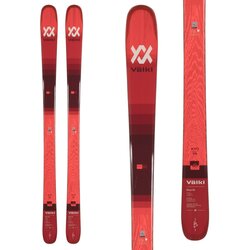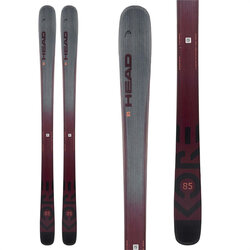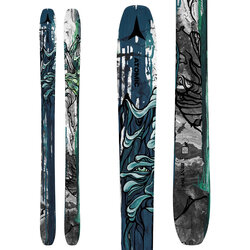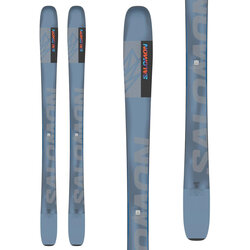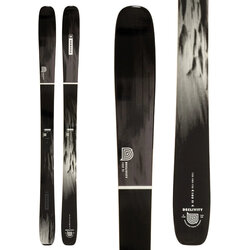
How to Choose the Right Skis for You
Everything you need to know.
It can be hard to know what ski to purchase. We're going to start with the most basic part of picking a ski - what size is right for you. Mostly, size is based on your height, but your skier ability, experience and where you ski can influence your choice as well. Let's get started!
Want our help? Use our Ski Finder.
Ski Sizing
What length should you choose?
Many factors go into determining the correct size ski for a skier. But, In general and as a starting point, the proper ski length is somewhere between your chin and the top of your head. For example, a 6' skier will want to look for skis between 170cm and 190cm. We always say that, in general, beginner skiers should look for a ski that comes up to between their chin and upper lip; Intermediate skiers between their upper lip and eyebrows; and advanced skiers eyebrows to the top of their head. Again these are very general recommendations. The exact right size for you will depend on your skiing ability and style. Use the chart below to get a sense of ski length for your height. Don't get too hung up on the numbers though. A centimeter or two longer or shorter won't make a meaningful difference.
Ski Sizing Chart
| Skier Height | Ski Length (cm) | |||
|---|---|---|---|---|
| ft / in | cm | Beginner | Intermediate | Expert |
| 4'4" | 132 | 120 | 130 | 140 |
| 4'6" | 137 | 125 | 135 | 145 |
| 4'8" | 142 | 130 | 140 | 150 |
| 4'10" | 147 | 135 | 145 | 155 |
| 5' | 152 | 140 | 150 | 160 |
| 5'2" | 158 | 145 | 155 | 165 |
| 5'4" | 163 | 150 | 160 | 170 |
| 5'6" | 168 | 155 | 165 | 175 |
| 5'8" | 173 | 160 | 170 | 180 |
| 5'10" | 178 | 165 | 175 | 185 |
| 6' | 183 | 170 | 180 | 190 |
| 6'2" | 188 | 175 | 185 | 190+ |
| 6'4" | 193 | 180 | 190 | 190+ |
How does ability level play into ski choice?
With modern design and construction, ability level has become less important as a factor when choosing a ski. Modern skis are easier to ski across all the different types of skis on the market. These days, it is possible for beginner skiers to ski a much wider variety of sks. That said, there are features and characteristics of skis that make one more appropriate for skiers of different abilities.
Beginner / Intermediate Skis |  |
These are skiers who are just starting on their ski journey or maybe have been renting for some time and now want to have their own gear to save time at the mountain and money over the long term. Typically, beginner skis have a softer flex, are narrower at the waist/underfoot, they use composite and they use foam or softer wood cores. When designing beginner skis, the manufacturers are trying to create skis that are easy to ski for someone who is developing their technique and a ski that is forgiving if the skier makes a mistake.
Intermediate / Advanced Skis |  |
This is the largest category of skiers and skis on the market. Intermediate/Advanced skiers ski the most variety of terrain - from groomers to deep powder. These skis are generally somewhat wider than beginner-intermediate skis, with a stronger wood core and sandwich sidewall construction.
Advanced / Expert Skis |  |
More aggressive and experienced skiers fall into this category. Whether skiing deep powder in the woods or carving super sonic turns on the groomers, advanced/expert skiers look for skis that will deliver the best response and experience at high speeds and in the widest variety of conditions. To achieve this level of performance, these skis use layers of metal and composites. The side effect of this increased level of response is that these skis are typically stiffer along their length (longitudinally) and torsionally. Thus, a ski targeted at advanced and expert skiers can be harder for beginner skiers to ski at slow speeds.
Ski Dimensions
There are a few key measurements of a skis shape that can help to characterize it and tell you what it is intended to do and how it will likely perform when you put it down on snow. And lucky for us, almost every manufacturer prints these measurements right on the ski! The shape of a ski is described by a 3-number set of measurements. They are typically printed in one of the following two formats: 115/90/107 or 115-90-107. The first number, in this example 115, is the width of the tip of the ski. The second is the waist width (sometimes referred to as the “underfoot” measurement). And the last number is the tail width.
Ski Waist Width
Waist width is the most common measurement discussed when selecting a ski aside from ski length. This again is the measurement at the waist or underfoot portion of the ski and usually also the narrowest point on the ski. Waist width can tell you a lot about a ski. It speaks to how easy a ski will be to turn and also how it will perform in deeper powder and ungroomed snow conditions. The narrower underfoot of a ski is the easier it is to turn and get the ski up on edge and link turns. Skis with wider waists will have better floatation and will perform better in deeper, power snow.Ski Turning Radius
Along with the ski’s tip, waist and tail dimensions, the turn radius is also printed on the ski. The turn radius describes the sidecut of the ski. It is a way to quantify the relationship between the waist measurement of the ski to the tip and tail measurements. The turn radius is most often expressed in meters - ex. 17.8m. The narrower the ski’s waist, the deeper the sidecut. Skis with narrower waists and deeper sidecuts will have a shorter turn radius and make quicker turns. Skis with less extreme sidecuts will have a longer turn radius and will turn more slowly and be more stable at higher speeds.| Turning Radius | Turn Type | Type of Skiing and Skier Ability |
|---|---|---|
| < 16m | Short | Carving Skis and All-Mountain/Powder Skis with Tapered Tips and Tails |
| 17-22m | Medium | All-Mountain Skis, Park & Pipe Skis |
| > 22m | Long | Powder & Big-Mountain Skis |
Choosing Skis based on Terrain
Although the lines between different types of skis get blurrier and blurrier each year as manufacturers are making skis more and more versatile, the terrain and conditions in which you plan to use your skis plays an important role in choosing the best skis for you. The key is to figure out where you will be spending the majority of your time on the mountain and what type of terrain you like to ski most.


